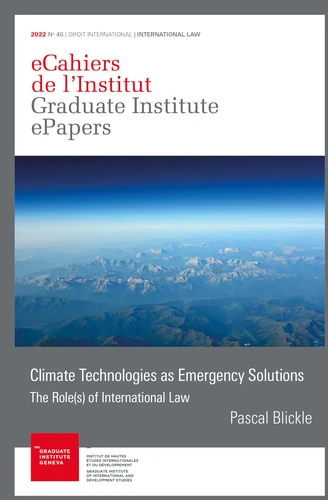Climate Technologies as Emergency Solutions. The role(s) of International Law
Par :Formats :
Disponible dans votre compte client Decitre ou Furet du Nord dès validation de votre commande. Le format Multi-format est :
- Pour les liseuses autres que Vivlio, vous devez utiliser le logiciel Adobe Digital Edition. Non compatible avec la lecture sur les liseuses Kindle, Remarkable et Sony
 , qui est-ce ?
, qui est-ce ?Notre partenaire de plateforme de lecture numérique où vous retrouverez l'ensemble de vos ebooks gratuitement
Pour en savoir plus sur nos ebooks, consultez notre aide en ligne ici
- FormatMulti-format
- ISBN978-2-940600-35-9
- EAN9782940600359
- Date de parution07/01/2022
- Protection num.NC
- Infos supplémentairesMulti-format incluant PDF avec W...
- ÉditeurGraduate Institute Publications
Résumé
This paper discusses large-scale technologies, which are proposed as emergency solutions for avoiding catastrophic climate change. Their use is highly controversial, notably because of risks of large-scale environmental damage and the danger of distracting from other climate policies. Some of these technologies are known as geoengineering or climate engineering. This paper examines stratospheric aerosol injection, ocean fertilisation, and artificial islands as case studies.
As the analysis of the rules of international law relevant to these three technologies shows, international law takes on different and partly conflicting roles towards such technologies. Nonetheless, a strong precautionary legal core opposing risky technological endeavours can be identified. However, there is a danger of this precautionary stance of international law being diluted by research and new regulation that make emergency technologies appear as viable policy options.
International law does not currently safeguard against the promise of such technologies distracting from mitigation and adaptation. We extend our heartfelt thanks to the Vahabzadeh Foundation for financially supporting the publication of best works by young researchers of the Graduate Institute, giving a priority to those who have been awarded academic prizes for their master's dissertations.
As the analysis of the rules of international law relevant to these three technologies shows, international law takes on different and partly conflicting roles towards such technologies. Nonetheless, a strong precautionary legal core opposing risky technological endeavours can be identified. However, there is a danger of this precautionary stance of international law being diluted by research and new regulation that make emergency technologies appear as viable policy options.
International law does not currently safeguard against the promise of such technologies distracting from mitigation and adaptation. We extend our heartfelt thanks to the Vahabzadeh Foundation for financially supporting the publication of best works by young researchers of the Graduate Institute, giving a priority to those who have been awarded academic prizes for their master's dissertations.
This paper discusses large-scale technologies, which are proposed as emergency solutions for avoiding catastrophic climate change. Their use is highly controversial, notably because of risks of large-scale environmental damage and the danger of distracting from other climate policies. Some of these technologies are known as geoengineering or climate engineering. This paper examines stratospheric aerosol injection, ocean fertilisation, and artificial islands as case studies.
As the analysis of the rules of international law relevant to these three technologies shows, international law takes on different and partly conflicting roles towards such technologies. Nonetheless, a strong precautionary legal core opposing risky technological endeavours can be identified. However, there is a danger of this precautionary stance of international law being diluted by research and new regulation that make emergency technologies appear as viable policy options.
International law does not currently safeguard against the promise of such technologies distracting from mitigation and adaptation. We extend our heartfelt thanks to the Vahabzadeh Foundation for financially supporting the publication of best works by young researchers of the Graduate Institute, giving a priority to those who have been awarded academic prizes for their master's dissertations.
As the analysis of the rules of international law relevant to these three technologies shows, international law takes on different and partly conflicting roles towards such technologies. Nonetheless, a strong precautionary legal core opposing risky technological endeavours can be identified. However, there is a danger of this precautionary stance of international law being diluted by research and new regulation that make emergency technologies appear as viable policy options.
International law does not currently safeguard against the promise of such technologies distracting from mitigation and adaptation. We extend our heartfelt thanks to the Vahabzadeh Foundation for financially supporting the publication of best works by young researchers of the Graduate Institute, giving a priority to those who have been awarded academic prizes for their master's dissertations.



